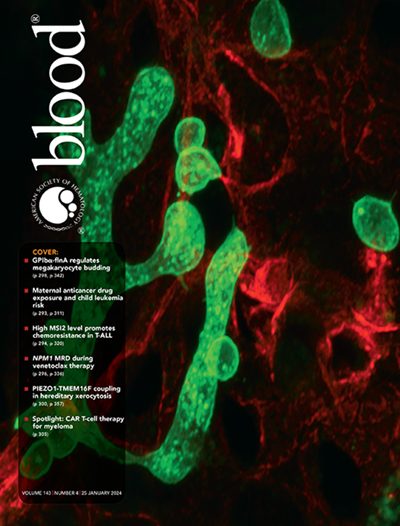髓系肿瘤TP53突变的临床指南。
IF 23.1
1区 医学
Q1 HEMATOLOGY
引用次数: 0
摘要
TP53突变在10-15%的髓系肿瘤中发现,是其最重要的预后因素之一。新数据显示,TP53突变等位基因状态是临床结果的关键决定因素,多发TP53突变髓系肿瘤预后非常差。临床和研究中用于评估TP53突变状态的方法存在显著差异,导致报告的患者特征、治疗反应和生存率存在差异。事实上,在不同的专业协会和具有里程碑意义的研究中,用于定义TP53突变状态的标准存在差异,这导致了混乱、不理想的临床试验和治疗建议的可变性。我们回顾了用于评估TP53突变等位基因状态的方法,并根据临床可用的测试提供建议,以便准确评估髓系肿瘤中TP53基因突变。热点突变占髓系肿瘤中所有TP53错义突变的约35%。有证据表明,这些热点突变可能具有显性负性或功能增益特性。在这里,我们回顾了这些证据,并讨论了TP53突变身份对患者预后和临床管理的潜在影响。本文章由计算机程序翻译,如有差异,请以英文原文为准。
A clinical guide to TP53 mutations in myeloid neoplasms.
TP53 mutations are found in 10-15% of myeloid neoplasms and are one of its most important prognostic factors. Emerging data show that TP53 mutational allele status is a key determinant of clinical outcomes, with multi-hit TP53 mutant myeloid neoplasms having a very poor prognosis. Significant differences exist among the methods used in clinical and research settings to assess TP53 mutational status, leading to variability in reported patient characteristics, response to therapy, and survival. Indeed, differences in the criteria used to define TP53 mutational states among professional societies and in landmark research studies have led to confusion, suboptimal clinical testing, and variability in therapy recommendations. We review the methods used to assess for TP53 mutational allele status and provide recommendations, based on clinically available testing, for the accurate evaluation of TP53 gene mutations in myeloid neoplasms. Hotspot mutations represent ~35% of all TP53 missense mutations in myeloid neoplasms. There is evidence that these hotspot mutations may have dominant-negative or gain-of function properties. Here, we review this evidence and discuss the potential impact of TP53 mutation identity on patient outcomes and clinical management.
求助全文
通过发布文献求助,成功后即可免费获取论文全文。
去求助
来源期刊

Blood
医学-血液学
CiteScore
23.60
自引率
3.90%
发文量
955
审稿时长
1 months
期刊介绍:
Blood, the official journal of the American Society of Hematology, published online and in print, provides an international forum for the publication of original articles describing basic laboratory, translational, and clinical investigations in hematology. Primary research articles will be published under the following scientific categories: Clinical Trials and Observations; Gene Therapy; Hematopoiesis and Stem Cells; Immunobiology and Immunotherapy scope; Myeloid Neoplasia; Lymphoid Neoplasia; Phagocytes, Granulocytes and Myelopoiesis; Platelets and Thrombopoiesis; Red Cells, Iron and Erythropoiesis; Thrombosis and Hemostasis; Transfusion Medicine; Transplantation; and Vascular Biology. Papers can be listed under more than one category as appropriate.
 求助内容:
求助内容: 应助结果提醒方式:
应助结果提醒方式:


